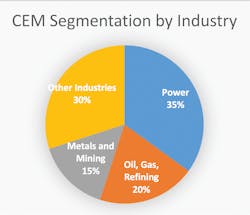Mcilvaine: Continuous emissions monitoring and process control
Bob Mcilvaine is the president of the Mcilvaine Company in Northfield, Illinois. The Mcilvaine Company provides market research and technical analyses on industrial processing sectors and equipment. Mcilvaine may be reached at [email protected] or 847-784-0012, ext. 112.
In many countries, the emissions of air pollutants from each large stack are measured continuously. This data is supplied to regulatory agencies who theoretically can be viewing all this data in real time, and this data is also being continuously integrated into operator process management systems. Due to the high priority placed on eliminating emissions, the operation of the process is tailored to meeting the emissions goals. As a result, process instrumentation and emissions instrumentation are working in tandem.
China is a world leader in coordinating coal-fired power plant operation and emissions reductions. The goal is to make coal-fired power plants as clean as the best operated gas turbine plant. The acronym for the program is HELE (High Efficiency, Low Emissions). Large Chinese power plants operate with fewer CO2 emissions than plants anywhere else in the world. The country operates over 300,000 MW of ultra-supercritical coal-fired plants. These combustors, operating at very high pressures and temperatures, increase efficiency and reduce CO2 emissions by 30% compared to most plants. By contrast, the U.S. has only one ultra-supercritical plant of 600 MW.
The Chinese government is so concerned about operating these plants with the lowest possible emissions of acid gases, dust, mercury, NOx and organics that it has encouraged third-party operation of the air pollution control systems. The belief is that capable and reliable specialized companies who are dedicated to emission minimization will be the most reliable operators.
Ultra-supercritical coal-fired units monitor CO, CO2, oxygen and other constituents in the boiler. A more recent development has been to monitor these gases at various points within the combustor and then adjust burners for optimum operation. One example is the Yokogawa tunable diode laser, which provides real-time measurement of carbon monoxide in a furnace.
Another approach is used by GE. It supplies neural networks that operate on an empirical principle. The software measures the results with various burner combinations and selects the best.
Instrumentation to measure liquids and solids often needs to be integrated with the air pollution control system. One practice is coal blending to optimize performance. This requires accurate measurement of each type of coal. Volumetric measurement is inferior to weight measurement. Thermo Fisher, Emerson and others have gravity-measuring devices for flowing solids. This need to accurately measure materials in the process extends to many industries including oil and gas, pulp and paper, chemicals and pharmaceuticals.
Pollutants in the fuel vary considerably. There are volatile constituents in a product being processed that result in emissions. For example, the limestone calcined in a kiln to make cement has varying quantities of mercury. It volatilizes in the kiln and then must be captured in the air pollution control system. Thermo Fisher has laboratory instruments to measure the mercury in the limestone. These periodic measurements can be integrated into the process management system, which also measures mercury in exit gases from the kiln.
Liquids measurement can also be critical to reducing air emissions. Scrubbers, which were expected to capture 80% of the mercury in the incoming gases, were instead at times showing emission increases. The chloride levels in the recirculating scrubbing liquor were identified as a culprit. Chloride measurement and control was the answer.
Continuous emissions monitors are installed in more than 200,000 stacks around the world. The biggest investment is in coal-fired boilers, gas turbines and waste to energy plants.1
The most common measurement is particulate followed by acid gases, NOx, volatile organics and metals. Many systems measure all the pollutants in a stack. It is only recently that process management systems have used a holistic approach and included liquids and solids. The technology continues to evolve as do the regulatory approaches.
References:
1. IIoT and Remote O&M published by the McIlvaine Company
